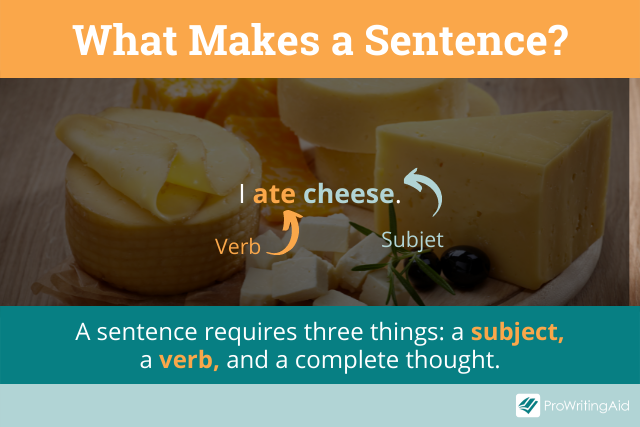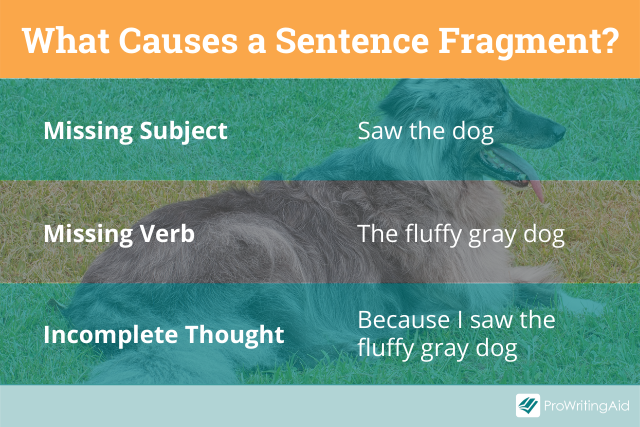Sentence Fragments: What They Are and How to Correct Them

Sentence fragments are one of the most common grammar mistakes you should look out for in your writing.
A sentence fragment is an incomplete sentence that is missing an important element.
Read on to learn more about sentence fragments and find out how to fix them.
What Is a Sentence Fragment?
A sentence fragment is another term for an incomplete sentence.
A sentence is a group of words that includes a subject, a verb, and expresses a complete thought.
- Subject: the subject is the noun or pronoun that is doing something in a sentence. Essentially, the subject tells us who or what is performing the verb in the sentence.
- Verb: the verb is the action or state of being performed by the subject of the sentence. It tells us what the subject is being or doing.
- Complete thought: the sentence makes sense without any extra information.

For example, consider the sentence, “The hungry dog ate a cheeseburger.”
This is a complete sentence, also known as an independent clause, because it fulfills all three sentence requirements. It has a subject (“the hungry dog”), a verb (“ate”), and it expresses a complete thought.
When one element of an independent clause (the subject, verb, or complete thought) is missing, you have a sentence fragment. For example, “Ate a cheeseburger.” and “The hungry dog.” are both sentence fragments.

What Causes a Sentence Fragment?
There are three things that can cause a sentence fragment—a missing subject, a missing verb, or an incomplete thought.
To fix a sentence fragment, you need to identify which element is causing the issue.
Let’s look at each of these three possible issues in more detail.
Missing Verb
Some sentence fragments are missing a verb.
For example, consider the sentence fragment, “A girl with a yellow backpack.”
This sentence fragment contains a subject (“a girl”), but it lacks a verb. We don’t know what the girl is doing, so this sentence requires additional information to make sense.
Missing Subject
Some sentence fragments are missing a subject.
For example, consider the sentence fragment, “Ran away from home.”
This sentence fragment contains a verb (“ran”), but it lacks a subject. We don’t know who’s running away from home.
Missing Complete Thought
Some sentence fragments are dependent clauses.
A dependent clause is a group of words that contains a subject and verb, but doesn’t tell a whole story. It needs to be connected to an independent clause because it cannot stand on its own as a complete sentence.
For example, consider the sentence fragment, “When the clock struck nine.”
This sentence fragment has both a subject (“the clock”) and a verb (“struck”), but it doesn’t express a complete thought. We don’t know what happened at nine.
Many dependent clauses start with a coordinating or subordinating conjunction, like "although," "until," or "while." If your sentence starts with one of these phrases, that might be a sign that it needs another sentence to tell a complete story.

Sentence Fragment Examples
See if you can identify which element is missing from each of the following sentence fragment examples.
Going to the store.
The dog under the car.
Because they left early.
If no one can hear me.
My least favorite chore.
These examples are missing one or more crucial components that prevent them from being a complete sentence.
How to Correct Sentence Fragments
Correcting sentence fragments is easy; you need to identify the missing puzzle piece and then add it in.
In the first example, the subject is missing. The fragment includes the verb “going,” but doesn’t establish who or what is going to the store.
- Corrected version: I am going to the store. (Subject added: I)
In the second example, the verb is missing. The fragment includes a subject, “the dog,” but doesn’t establish its action or state of being. We are left wondering what happened to the dog under the car.
- Corrected version: The dog under the car is frightened. (Verb added: is; thought completed: frightened)
In the third example, the sentence fragment (dependent clause) includes a subject, “they,” and a verb, “left,” so we know who did what. However, the fragment leaves us with a question: what happened because they left early?
- Corrected version: Because they left early, they beat the traffic. (Thought completed: they beat the traffic)
The fourth example is another dependent clause. We have a subject (“no one”) and a verb (“hear”), but the fragment leaves us with a question: what happens when no one can hear the speaker?
- Corrected version: I sing loudly if no one can hear me. (Thought completed: I sing loudly)
In the fifth example, we have a subject (“my least favorite chore”) and nothing else to complete the thought. This phrase needs to be attached to a complete sentence to make sense.
- Correct version: I had to clean the toilet—my least favorite chore. (Thought completed: I had to clean the toilet)
You can use a grammar checking tool like ProWritingAid to catch your sentence fragments and see different ways to correct them.
Some sentence fragments are really difficult to identify, such as “Looking forward to seeing you.” ProWritingAid can do the hard work for you and ensure you don't overlook any hard-to-spot sentence fragments like this.

Final Words
You can break grammar rules for artistic purposes, for example, if you want to create an interesting rhythm or emphasize certain words.
Before you break the rules, however, you need to show that you know the rules, which means most of your sentences should be complete.
If you use sentence fragments, they need to be purposeful, and the ideas they convey need to be clear to your reader.
Now you know how to identify and correct sentence fragments. Using complete sentences will strengthen your work and help make your writing shine!










